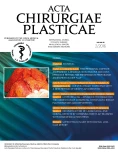Editorial
Published in:
ACTA CHIRURGIAE PLASTICAE, 58, 2, 2016, pp. 59
Category:
Editorial
It is a pleasure to see how our journal, Acta chirurgiae plasticae, changed dramatically under the new editor-in-chief, Aleš Fibír, M.D. The journal is now published more regularly, it is easier to contribute in it, it is peer-reviewed and formally it is more alike famous journals from abroad. It is just less than two years ago when Aleš Fibír, M.D. took over the position of the editor-in-chief and I wish he keeps his enthusiasm for this demanding work to cultivate and increase prestige of this journal.
We, as the members of today’s generation of Czech plastic surgeons, take the existence of Acta chirurgiae plasticae journal as an obvious grant from previous times (generations), maybe not appreciating correctly it’s true value. It has quite a long history that started in 1959; it has connection with internationally recognized name of prof. Burian; it has independence of selection what is going to be published; it provides a unique possibility to share ideas and experience of those of us who want to be known internationally. And it is maintained by quite a small Czech Society of Plastic Surgery CzMA (130 active members). We, as the members of the Czech Society of Plastic Surgery, should be proud to have such a great journal that is so valuable for our professional life. I strongly believe that it will be more and more rewarding to contribute to our journal and finally it will be a privilege to have an article accepted by this journal.
Today’s issue is designated to breast reconstruction, the topic that keeps standard and strong position in the specialty of plastic surgery. However, think about breast reconstruction in the eyes of breast oncology professionals and also in the eyes of the patients. How many patients are actually offered to undergo breast reconstruction? My estimation is that only about 200 patients underwent autologous reconstructions and about 500 patients underwent implant reconstruction in 2015. That is probably only 10% of new breast cancer patients, since part of these reconstructions were done after prophylactic mastectomy. And for how many have we performed immediate reconstruction after therapeutic mastectomy? There were very few flaps and not many implants. How many oncological centers offer breast reconstruction performed by plastic surgeons on regular basis? What about evaluation and audit of our results? How many complications do we have, how many happy patients do we have? How efficient is prophylactic mastectomy, which we, as plastic surgeons, perform? Many questions need to be answered and there is still a long way to achieve the highest possible standard of plastic surgery role in the process of prevention, treatment and also recovery from breast cancer disease.
I believe that today’s issue of Acta chirurgiae plasticae will be a useful contribution to our knowledge about breast reconstruction and also another evidence of viability of this journal.
Assoc. Prof. Luboš Dražan, M.D., PhD.
Department of Plastic and Aesthetic Surgery
St. Anne’s University Hospital Brno
Labels
Plastic surgery Orthopaedics Burns medicine TraumatologyArticle was published in
Acta chirurgiae plasticae

2016 Issue 2
- Metamizole vs. Tramadol in Postoperative Analgesia
- Current Insights into the Antispasmodic and Analgesic Effects of Metamizole on the Gastrointestinal Tract
- Spasmolytic Effect of Metamizole
- Metamizole at a Glance and in Practice – Effective Non-Opioid Analgesic for All Ages
- Safety and Tolerance of Metamizole in Postoperative Analgesia in Children
Most read in this issue
- Lipomodelling – advanced technique for the correction of Congenital hypoplastic breast malformations and deformities
- Reconstruction of large facial and orbital defects by combining free flap transfer with craniofacial prosthesis
- UPPER EYELID INJURY WITH PARTIAL LOSS. CASE REPORT
- TRIDIMENSIONAL DOPPLER ASSESSMENT: A RELIABLE, NON-INVASIVE AND COST-EFFECTIVE METHOD FOR PREOPERATIVE PERFORATOR ASSESSMENT IN DIEP FLAP

